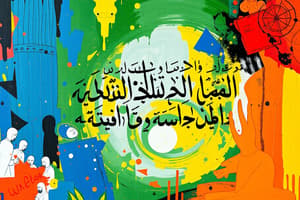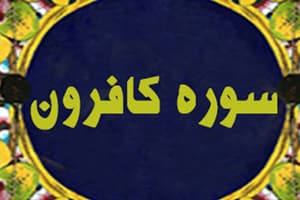Podcast
Questions and Answers
What is the main theme addressed in Surah As-Sajdah?
What is the main theme addressed in Surah As-Sajdah?
- Historical events of the prophets
- The beauty of nature
- Economic challenges
- The consequences of disbelief (correct)
Surah As-Sajdah was revealed during a time of peace for the Muslims.
Surah As-Sajdah was revealed during a time of peace for the Muslims.
False (B)
What major event does Surah As-Sajdah affirm will happen after death?
What major event does Surah As-Sajdah affirm will happen after death?
Resurrection
Surah As-Sajdah includes a command for __________ as a sign of submission to God.
Surah As-Sajdah includes a command for __________ as a sign of submission to God.
Match the following themes in Surah As-Sajdah with their descriptions:
Match the following themes in Surah As-Sajdah with their descriptions:
Which of the following is NOT a quality of true believers mentioned in Surah As-Sajdah?
Which of the following is NOT a quality of true believers mentioned in Surah As-Sajdah?
The Surah suggests that all individuals will not be held accountable for their deeds.
The Surah suggests that all individuals will not be held accountable for their deeds.
What does Surah As-Sajdah encourage believers to do amidst challenges?
What does Surah As-Sajdah encourage believers to do amidst challenges?
The Surah discusses the creation of humans from __________.
The Surah discusses the creation of humans from __________.
What does the concept of 'Resurrection and Accountability' emphasize?
What does the concept of 'Resurrection and Accountability' emphasize?
The historical context suggests that early Muslims faced comfort and prosperity during the revelation period.
The historical context suggests that early Muslims faced comfort and prosperity during the revelation period.
What is the primary purpose of the Signs of God theme?
What is the primary purpose of the Signs of God theme?
The use of __________ rhetoric in Arabic enhances the conveyance of deep meanings in the verses.
The use of __________ rhetoric in Arabic enhances the conveyance of deep meanings in the verses.
Match the following themes with their descriptions:
Match the following themes with their descriptions:
What does the theme of 'Encouragement of Prayer and Worship' advocate for?
What does the theme of 'Encouragement of Prayer and Worship' advocate for?
The Tafsir literature provides insights that focus solely on the historical context of the verses.
The Tafsir literature provides insights that focus solely on the historical context of the verses.
What is a significant aspect of the spiritual significance of Surah As-Sajdah?
What is a significant aspect of the spiritual significance of Surah As-Sajdah?
The Surah responds to skepticism regarding __________ and life after death.
The Surah responds to skepticism regarding __________ and life after death.
Which theme discusses the challenges posed by polytheistic beliefs in Mecca?
Which theme discusses the challenges posed by polytheistic beliefs in Mecca?
Study Notes
Historical Context
- Surah As-Sajdah (Chapter 32) is a Meccan Surah, revealed during a time when Muslims faced oppression.
- The Surah addresses the disbelievers' rejection of the Prophet Muhammad's message.
- It emphasizes the consequences of disbelief and the signs of God's existence and power in creation.
Themes and Messages
-
The Nature of Revelation
- Highlights the divine origin of the Quran.
- Emphasizes that the Quran is a source of guidance.
-
Creation and Signs of God
- Discusses the creation of humans from clay and the stages of human development.
- Encourages reflection on natural phenomena as signs of God's existence.
-
Resurrection and Accountability
- Affirms the concept of resurrection after death.
- Stresses that all individuals will be held accountable for their deeds.
-
Response of the Believers
- Describes the qualities of true believers and their steadfastness in faith.
- Encourages patience and reliance on God amidst adversity.
-
Consequences of Disbelief
- Warns of dire consequences for those who reject faith.
- Illustrates the fate of past nations that denied their prophets.
-
Sajdah (Prostration)
- The Surah includes a command for prostration as a sign of submission to God.
- Prostration symbolizes humility and recognition of God’s greatness.
-
Hope for the Believers
- Offers reassurance to believers about ultimate success and rewards.
- Encourages perseverance in faith despite challenges.
Historical Context
- Surah As-Sajdah (Chapter 32) was revealed in Mecca during a period of significant oppression against Muslims.
- The Surah addresses the skepticism and rejection faced by Prophet Muhammad from disbelievers.
- It underscores the dire consequences of disbelief while emphasizing the signs of God's existence and creative power.
Themes and Messages
-
The Nature of Revelation
- Establishes the Quran's divine origin as a guiding framework for humanity.
-
Creation and Signs of God
- Describes human creation from clay and various developmental stages.
- Stimulates reflection on natural phenomena that indicate God’s presence and mastery over creation.
-
Resurrection and Accountability
- Affirms belief in life after death and resurrection.
- Stresses personal accountability for all actions and deeds in the afterlife.
-
Response of the Believers
- Depicts characteristics of true believers, emphasizing steadfastness in faith.
- Urges patience and dependence on God in times of hardship and adversity.
-
Consequences of Disbelief
- Issues stern warnings regarding the repercussions faced by individuals who reject faith.
- Provides examples of past nations that met with punishment for denying their prophets.
-
Sajdah (Prostration)
- Commands believers to perform prostration as an act of submission to God.
- Prostration serves as a symbol of humility and acknowledgment of God’s unparalleled greatness.
-
Hope for the Believers
- Instills reassurance among believers regarding eventual success and divine rewards.
- Encourages perseverance and steadfastness in faith despite facing challenges and trials.
Themes and Messages
- The belief in one God and His sovereignty is a central theme, asserting divine uniqueness and power.
- Creation of humans and the universe is attributed solely to God, highlighting His role as the ultimate Creator.
- The reality of resurrection and accountability on the Day of Judgment underscores moral responsibility for individual actions.
- Natural phenomena are presented as signs of God's existence, prompting reflection on His omnipotence.
- Believers are encouraged to express their faith through submission to God's will, emphasizing actions and patience as vital components.
Historical Context
- The revelation emerged during a period of severe persecution for early Muslims in Mecca, aiming to fortify their faith.
- Explicitly counters the prevalent polytheistic beliefs in Mecca, addressing the challenges posed by such ideologies.
- Responds to skepticism regarding resurrection and the afterlife, reinforcing the concept of divine accountability.
Interpretations and Commentary
- Tafsir literature by various scholars offers insights into the relevance of verses concerning faith and ethical conduct.
- Many commentaries note the thematic shift from creation discussions to the moral imperatives for humanity.
- Recitation of these verses holds spiritual significance, promoting reflection on God's divine attributes and personal faith.
Spiritual Significance
- Advocates for the practice of prayer and worship, particularly emphasizing the act of prostration (sajdah) as a sign of devotion.
- Offers hope and reassurance to believers by highlighting divine mercy and the promise of eternal life.
- Encourages contemplation of personal faith and awareness of the signs of God within the natural world.
Linguistic Analysis
- The use of eloquent Arabic rhetoric enhances the conveyance of deep meanings within the verses.
- Rich imagery and metaphor are employed to depict creation and the afterlife, fostering a deeper understanding and emotional engagement.
- The verses' rhythmic structure aids in memorization and recitation, showcasing the inherent beauty of the Arabic language.
Studying That Suits You
Use AI to generate personalized quizzes and flashcards to suit your learning preferences.
Description
This quiz explores Surah As-Sajdah (Chapter 32) of the Quran, focusing on its historical context and significant themes. Participants will learn about the nature of revelation, creation signs, resurrection, and the characteristics of true believers. Delve into the powerful messages and lessons conveyed in this Meccan Surah.




